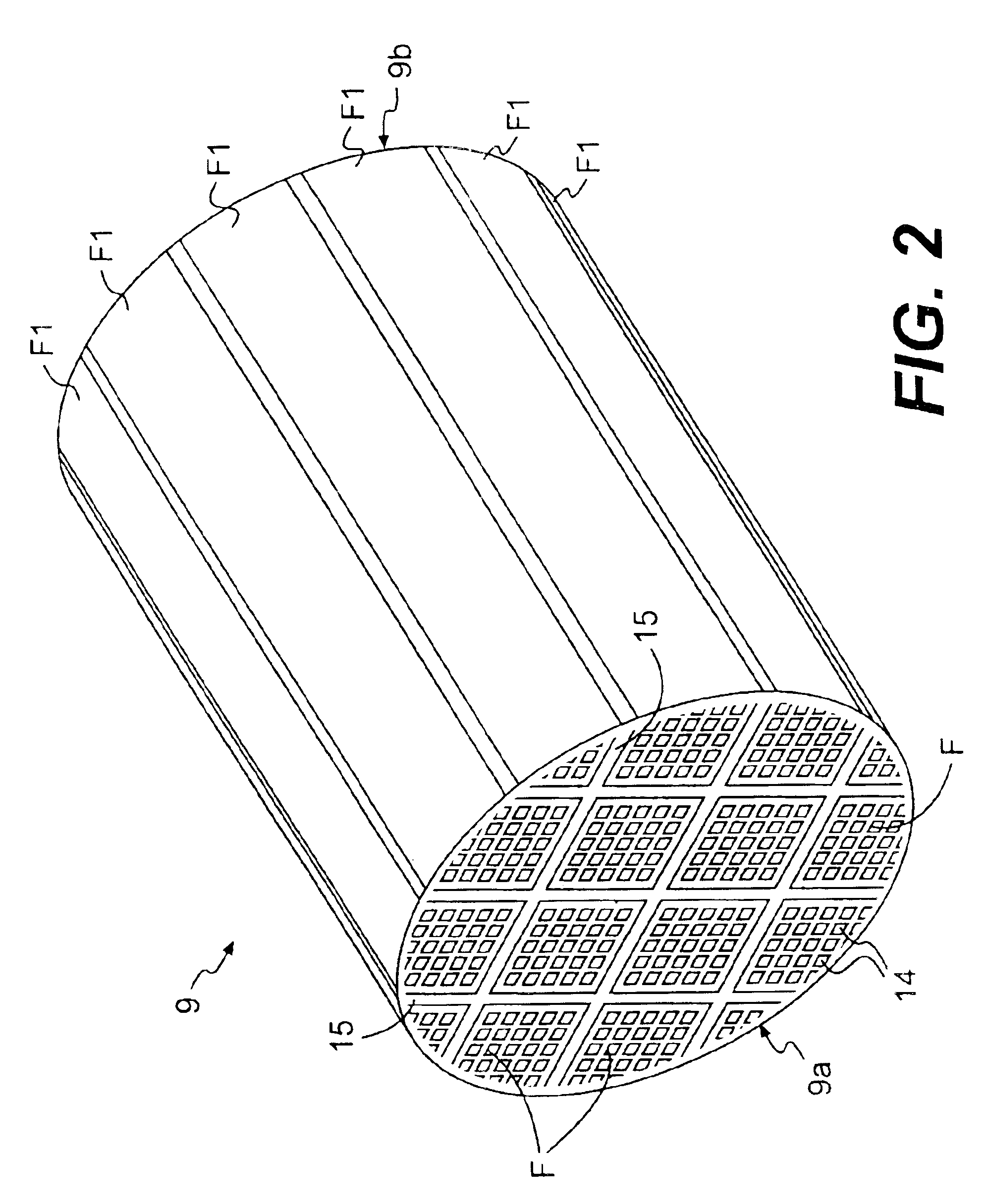Honeycomb filter and ceramic filter assembly
a technology of ceramic filter and honeycomb, which is applied in the direction of machines/engines, chemical/physical processes, domestic applications, etc., can solve the problems of power loss, affecting the environment, and reducing the number of sperms,
- Summary
- Abstract
- Description
- Claims
- Application Information
AI Technical Summary
Benefits of technology
Problems solved by technology
Method used
Image
Examples
example 1-1
[0092](1) 51.5 wt % of α silicon carbide powder having an average grain diameter of 10 μm and 22 wt % of α silicon carbide powder having an average grain diameter of 0.5 μm were wet-mixed. Then, 6.5 wt % of the organic binder (methyl cellulose) and 20 wt % of water were added to the obtained mixture and kneaded. Next, a small amount of the plastic agent and the lubricative agent were added to the kneaded mixture, further kneaded, and extruded to obtain the honeycomb molded product. More specifically, the α silicon carbide powder having an average particle diameter of about 10 μm was produced by Yakushima Denkou Kabushiki Kaisha under the product name of C-1000F, and the α silicon carbide powder having an average particle diameter of about 0.5 μm was produced by Yakushima Denkou Kabushiki Kaisha under the product name of GC-15.
[0093](2) Then, after drying the molded product with a microwave dryer, the through holes 12 of the molded product was sealed by the sealing paste made of sint...
examples 1-2 , 1-3
EXAMPLES 1-2, 1-3
[0099]In example 1-2, the ceramic filter assembly 9 was prepared by setting the thickness t1 of the seal layer 15 at 1.0 mm. The other conditions were basically set in accordance with example 1-1. In example 3, the ceramic filter assembly 9 was formed by setting the thickness t1 of the seal layer 15 at 2.5 mm. The other conditions were basically set in accordance with example 1-1.
[0100]Then, the obtained two types of assemblies 9 were used for a certain period, and the cut surfaces were observed with the naked eye. The same desirable results as example 1-1 were obtained. Thus, it is apparent that the exhaust gas was efficiently processed in examples 1-2 and 1-3.
example 1-4
[0101]In example 1-4, the employed seal layer forming paste was prepared by mixing and kneading 25 wt % of a ceramic fiber (mullite fiber, shot content rate 5 wt %, fiber length 0.1 mm-100 mm), 30 wt % of silicon nitride powder having an average grain diameter of 1.0 μm, 7 wt % of alumina sol (the conversion amount of alumina sol being 20% serving as an inorganic binder, 0.5 wt % of poly vinyl alcohol serving as an organic binder, and 37.5 wt % of alcohol. The other portions were formed in accordance with example 1-1 to complete the ceramic filter assembly 9. The thickness t1 of the seal layer 15 was set at 1.0 mm. The thermal conductivity of the seal layer 15 was 0.2 W / mK.
[0102]Then, the obtained assembly 9 was used for a certain period, and the cut surfaces were observed with the naked eye. The same desirable results as example 1 were obtained. Thus, it is apparent that the exhaust gas was efficiently processed in example 4.
PUM
| Property | Measurement | Unit |
|---|---|---|
| thickness | aaaaa | aaaaa |
| porosity | aaaaa | aaaaa |
| wt % | aaaaa | aaaaa |
Abstract
Description
Claims
Application Information
 Login to View More
Login to View More - R&D
- Intellectual Property
- Life Sciences
- Materials
- Tech Scout
- Unparalleled Data Quality
- Higher Quality Content
- 60% Fewer Hallucinations
Browse by: Latest US Patents, China's latest patents, Technical Efficacy Thesaurus, Application Domain, Technology Topic, Popular Technical Reports.
© 2025 PatSnap. All rights reserved.Legal|Privacy policy|Modern Slavery Act Transparency Statement|Sitemap|About US| Contact US: help@patsnap.com



